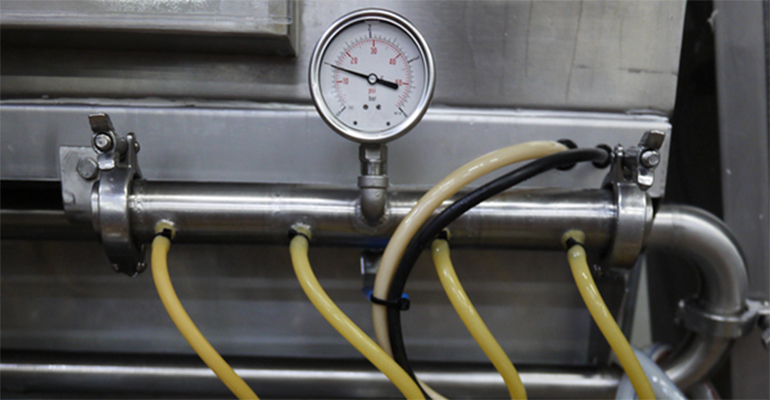Among several investigated alternative food processing technologies a few have established themselves in the food industry in the past 10 to 20 years. Here, Dr. Aganovic provides an introduction to a number of innovations, from high pressure (HPP) and pulsed electric fields (PEF), to UV and pulsed light, irradiation and alternative ways of heating the food found in applications.
High Pressure Processing
“HPP is a well-established technology for gentle preservation and shelf-life extension of several foods, such as juices, smoothies, fruit preparations, meat and fish products, ready-to-eat and ready-to-cook meals etc. HPP is a batch process where food is exposed to underwater pressure of up to 6000 bars for usually no longer then 2-3 min. Industrial machines are available in range from 35 to 525 L vessel volume, counting worldwide around 350 installations.”
High Pressure Homogenisation
“Another way of applying pressure is continuous high pressure homogenisation (HPH) up to pressure level of 4000 bar. The liquid product is forced under pressure through a very narrow homogenizing gap. This offers potential to microbial inactivation or cell disintegration in a very short time through a combined pressure, temperature and shear effect. Also, a small homogenizing gap allows formation of very small fat droplets and production of fine low-fat emulsion with improved qualities.”

Shockwaves
“Further dynamic continuous pressure application includes application of shockwaves. The process is based on electrical discharge under water to generate a pressure wave, with the aim of achieving disintegration of biological tissue, for example meat for increase of meat tenderness and decrease in required aging time. The technology is still at the research stage.”
Pulsed Electric Fields
“PEF technology is based on the application of high intensity electric field pulses of very short duration on the product contained between electrodes. This causes the effect of electroporation. Depending on the treatment intensity, the process can be applied for pore creation on biological cells for enhanced mass transfer (extraction, drying, distillation etc.), softening the tissue or electroporation of microbial cells for gentle preservation of liquids.”
“PEF allows shelf-life extension of fresh fruit and vegetable juices. Dependent on treatment intensity, the shelf life can be increased up to 20, 40 or even 60 days. Except for juices, the process is currently applied for preservation of cold brew coffee, ice cream mixtures and fruit preparations. Today there are approximately 90 PEF machines installed worldwide, of which around 60 are found in structure modification of potatoes, 10 for preservation of liquids and the rest 20 are used for research. PEF induced permeabilisation results in loss of turgor pressure and potato tissue softening, which in the end facilitates subsequent handling and cutting.”
Ohmic Heating, Radiofrequency and Microwave
“Ohmic heating, radiofrequency and microwave represent an alternative way of heating the food in a rapid manner, for the purposes of tempering, thawing or preservation.”
“The emission of light with different wavelengths has been introduced as a surface decontamination technique of food and food items. The application of light for decontamination of packaging films and materials represent a viable alternative for hydrogen peroxide, usually used for those purposes.”
“Ionizing irradiation uses electromagnetic rays with the purpose of inactivation of microorganisms and extension of shelf-life of different products (mostly spices). Depending on the country regulation, different food products and items may be irradiated. The process has been approved in over 60 countries worldwide.”


